小细胞肺癌nccn指南
- 格式:pptx
- 大小:2.26 MB
- 文档页数:36
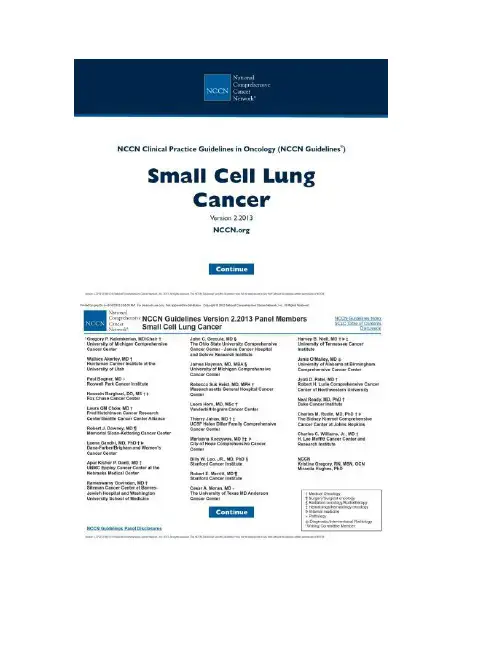
Printed by qing Bu on 8/16/2012 2:02:09 AM. For personal use only. Not approved for distribution. Copyright © 2012 National Comprehensive Cancer Network, Inc., All Rights Reserved. NCCN Guidelines Version 2.2013 Small Cell Lung Cancer 157. Maranzano E, Trippa F, Casale M, et al. 8Gy single-dose radiotherapy is effective in metastatic spinal cord compression: results of a phase III randomized multicentre Italian trial. Radiother Oncol 2009;93:174-179. Available at:/pubmed/19520448. 158. Lutz S, Berk L, Chang E, et al. Palliative radiotherapy for bone metastases: an ASTRO evidence-based guideline. Int J Radiat Oncol Biol Phys 2011;79:965-976. Available at:/pubmed/21277118. 159. Ferrell B, Koczywas M, Grannis F, Harrington A. Palliative care in lung cancer. Surg Clin North Am 2011;91:403-417, ix. Available at: /pubmed/21419260. 160. Tsao MN, Lloyd N, Wong RK, et al. Whole brain radiotherapy for the treatment of newly diagnosed multiple brain metastases. Cochrane Database Syst Rev 2012;4:CD003869. Available at:/pubmed/22513917. 161. Schneider BJ, Saxena A, DowneyRJ. Surgery for early-stage small cell lung cancer. J Natl Compr Canc Netw2011;9:1132-1139. Available at: /pubmed/21975913. 162. Lad T, Piantadosi S, Thomas P, et al. A prospective randomized trial to determine the benefit of surgical resection of residual disease following response of small cell lung cancer to combination chemotherapy. Chest 1994;106:320S-323S. Available at:/pubmed/7988254. 163. Rostad H, Naalsund A, Jacobsen R, et al. Small cell lung cancer in Norway. Should more patients have been offered surgical therapy? Eur J Cardiothorac Surg 2004;26:782-786. Available at:/pubmed/15450573. 164. Inoue M, Miyoshi S, Yasumitsu T, et al. Surgical results for small cell lung cancer based on the new TNM staging system. Thoracic Surgery Study Group of Osaka University, Osaka, Japan. Ann Thorac Surg 2000;70:1615-1619. Available at: /pubmed/11093496. NCCN Guidelines Index SCLC Table of Contents Discussion 165. Brock MV, Hooker CM, Syphard JE, et al. Surgical resection of limited disease small cell lung cancer in the new era of platinum chemotherapy: Its time has come. J Thorac Cardiovasc Surg 2005;129:64-72. Available at: /pubmed/15632826. 166. Lim E, Belcher E, Yap YK, et al. The role of surgery in the treatment of limited disease small cell lung cancer: time to reevaluate. J Thorac Oncol 2008;3:1267-1271. Available at: /pubmed/18978561. 167. Shields TW, Higgins GA, Jr., Matthews MJ, Keehn RJ. Surgical resection in the management of small cell carcinoma of the lung. J Thorac Cardiovasc Surg 1982;84:481-488. Available at:/pubmed/6289013. 168. Schreiber D, Rineer J, Weedon J, et al. Survival outcomes with the use of surgery in limited-stage small cell lung cancer: should its role be re-evaluated? Cancer 2010;116:1350-1357. Available at:/pubmed/20082453. 169. Inoue M, Nakagawa K, Fujiwara K, et al. Results of preoperative mediastinoscopy for small cell lung cancer. Ann Thorac Surg 2000;70:1620-1623. Available at: /pubmed/11093497. 170. Shepherd FA, Evans WK, Feld R, et al. Adjuvant chemotherapy following surgicalresection for small-cell carcinoma of the lung. J Clin Oncol 1988;6:832-838. Available at: /pubmed/2835443. 171. Tsuchiya R, Suzuki K, Ichinose Y, et al. Phase II trial of postoperative adjuvant cisplatin and etoposide in patients with completely resected stage I-IIIa small cell lung cancer: the Japan Clinical Oncology Lung Cancer Study Group Trial (JCOG9101. J REF-12 Version 2.2013, 07/06/12 © National Comprehensive Cancer Network, Inc. 2012, All rights reserved. The NCCN Guidelines® and this illustration may not be reproduced in any form without the express written permission of NCCN®.Printed by qing Bu on 8/16/2012 2:02:09 AM. For personal use only. Not approved for distribution. Copyright © 2012 National Comprehensive Cancer Network, Inc., All Rights Reserved. NCCN Guidelines Version 2.2013 Small Cell Lung Cancer Thorac Cardiovasc Surg 2005;129:977-983. Available at:/pubmed/15867769. 172. Johnson BE, Linnoila RI, Williams JP, et al. Risk of second aerodigestive cancers increases in patients who survive free of smallcell lung cancer for more than 2 years. J Clin Oncol 1995;13:101-111. Available at: /pubmed/7799009. 173. Johnson BE. Second lung cancers in patients after treatment for an initial lung cancer. J Natl Cancer Inst 1998;90:1335-1345. Available at: /pubmed/9747865. 174. Richardson GE, Tucker MA, Venzon DJ, et al. Smoking cessation after successful treatment of small-cell lung cancer is associated with fewer smoking-related second primary cancers. Ann Intern Med 1993;119:383-390. Available at: /pubmed/8393311. 175. Kawahara M, Ushijima S, Kamimori T, et al. Second primary tumours in more than 2-year disease-free survivors of small-cell lung cancer in Japan: the role of smoking cessation. Br J Cancer 1998;78:409-412. Available at:/pubmed/9703291. 176. Parsons A, Daley A, Begh R, Aveyard P. Influence of smoking cessation after diagnosis of early stage lung cancer on prognosis: systematic review of observational studies with meta-analysis. BMJ2010;340:b5569. Available at: /pubmed/20093278. 177.Travis W, Brambilla E, Müller-Hermelink H. World Health Organization Classification of tumours: Pathology and genetics of tumours of the lung, pleura, thymus and heart. Lyon, France: IARC Press; 2004. 178. Bajetta E, Catena L, Procopio G, et al. Is the new WHO classification of neuroendocrine tumours useful for selecting an NCCN Guidelines Index SCLC Table of Contents Discussion appropriate treatment? Ann Oncol2005;16:1374-1380. Available at: /pubmed/15939719. 179. Kalemkerian GP. Pulmonary neuroendocrine carcinomas: progress and pitfalls. J Natl Compr Canc Netw 2011;9:1081-1082. Available at:/pubmed/21975910. 180. Varlotto JM, Medford-Davis LN, Recht A, et al. Should large cell neuroendocrine lung carcinoma be classified and treated as a small cell lung cancer or with other large cell carcinomas? J Thorac Oncol2011;6:1050-1058. Available at: /pubmed/21566535. 181. Travis WD, Giroux DJ, Chansky K, et al. The IASLC Lung Cancer Staging Project: proposals for the inclusion of broncho-pulmonary carcinoid tumors in the forthcoming (seventh edition of the TNM Classification for Lung Cancer. J Thorac Oncol2008;3:1213-1223. Available at: /pubmed/18978555. 182. Pusceddu S, Catena L, Valente M, et al. Long-term follow up of patients affected by pulmonary carcinoid at the Istituto Nazionale Tumori of Milan: a retrospective analysis. J Thorac Dis 2010;2:16-20. Available at: /pubmed/22263011. 183. Kyriss T, Maier S, Veit S, et al. Carcinoid lung tumors: long-term results from 111 resections. Thorac Surg Sci 2006;3:Doc03. Available at:/pubmed/21289951. 184. Rea F, Rizzardi G, Zuin A, et al. Outcome and surgical strategy in bronchial carcinoid tumors: single institution experience with 252 patients. Eur J Cardiothorac Surg 2007;31:186-191. Available at: /pubmed/17140801. 185. Detterbeck FC. Management of carcinoid tumors. Ann Thorac Surg 2010;89:998-1005. Available at:/pubmed/20172187. Version 2.2013, 07/06/12 © National Comprehensive Cancer Network, Inc. 2012, All rights reserved. The NCCN Guidelines®and this illustration may not be reproduced in any form without the express written permission of NCCN®. REF-13Printed by qing Bu on 8/16/2012 2:02:09 AM. For personal use only. Not approved for distribution. Copyright © 2012 National Comprehensive Cancer Network, Inc., All Rights Reserved. NCCN Guidelines Version 2.2013 Small Cell Lung Cancer 186. Cardillo G, Sera F, Di Martino M, et al. Bronchial carcinoid tumors: nodal status and long-term survival after resection. Ann Thorac Surg 2004;77:1781-1785. Available at: /pubmed/15111186. 187. Wirth LJ, Carter MR, Janne PA, Johnson BE. Outcome of patients with pulmonary carcinoid tumors receiving chemotherapy or chemoradiotherapy. Lung Cancer 2004;44:213-220. Available at: /pubmed/15084386. 188. Yao JC, Phan AT, Chang DZ, et al. Efficacy of RAD001 (everolimus and octreotide LAR in advanced low- to intermediategrade neuroendocrine tumors: results of a phase II study. J Clin Oncol 2008;26:4311-4318. Available at: /pubmed/18779618. 189. Moertel CG, Kvols LK, O'Connell MJ, Rubin J. Treatment of neuroendocrine carcinomas with combined etoposide and cisplatin. Evidence of major therapeutic activity in the anaplastic variants of these neoplasms. Cancer 1991;68:227-232. Available at:/pubmed/1712661. 190. Ekeblad S, Sundin A, Janson ET, et al. Temozolomide as monotherapy is effective in treatment of advanced malignant neuroendocrine tumors. Clin Cancer Res 2007;13:2986-2991. Available at:/pubmed/17505000. 191. Kulke MH, Hornick JL, Frauenhoffer C, et al. O6-methylguanine DNA methyltransferase deficiency and response to temozolomidebased therapy in patients with neuroendocrine tumors. Clin Cancer Res 2009;15:338-345. Available at: /pubmed/19118063. 192. Kulke MH, Lenz HJ, Meropol NJ, et al. Activity of sunitinib in patients with advanced neuroendocrine tumors. J Clin Oncol 2008;26:3403-3410. Available at:/pubmed/18612155. NCCN Guidelines Index SCLC Tableof Contents Discussion 193. Pavel ME, Hainsworth JD, Baudin E, et al. Everolimus plusoctreotide long-acting repeatable for the treatment of advanced neuroendocrine tumours associated with carcinoid syndrome (RADIANT-2: a randomised, placebo-controlled, phase 3 study. Lancet 2011;378:2005-2012. Available at:/pubmed/22119496. Version 2.2013, 07/06/12 © National Comprehensive Cancer Network, Inc. 2012, All rights reserved. The NCCN Guidelines® and this illustration may not be reproduced in any form without the express written permission of NCCN®. REF-14。

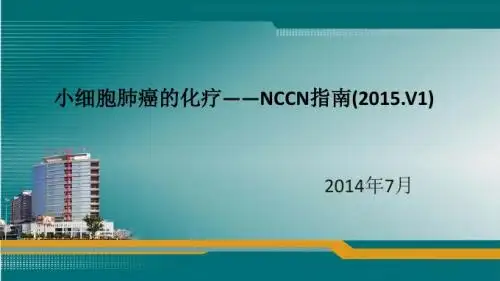

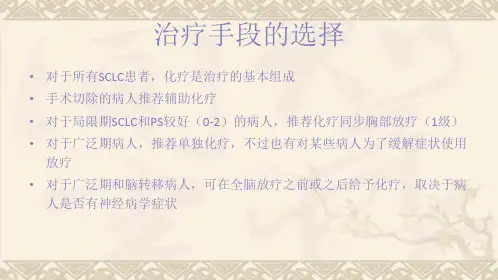
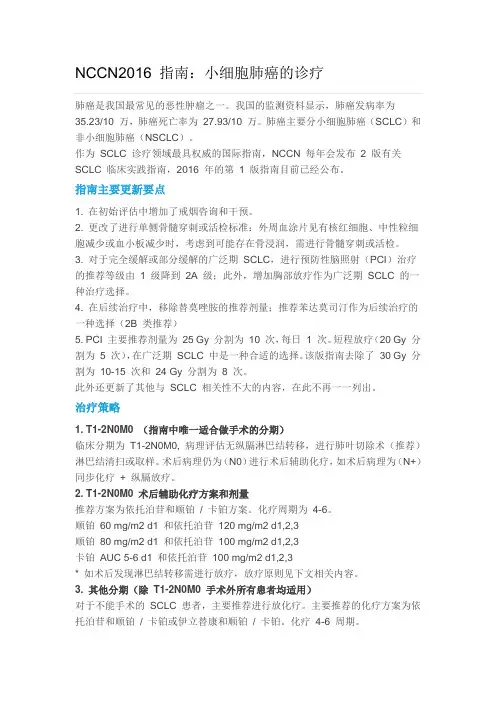
NCCN2016 指南:小细胞肺癌的诊疗肺癌是我国最常见的恶性肿瘤之一。
我国的监测资料显示,肺癌发病率为35.23/10 万,肺癌死亡率为27.93/10 万。
肺癌主要分小细胞肺癌(SCLC)和非小细胞肺癌(NSCLC)。
作为SCLC 诊疗领域最具权威的国际指南,NCCN 每年会发布 2 版有关SCLC 临床实践指南,2016 年的第1 版指南目前已经公布。
指南主要更新要点1. 在初始评估中增加了戒烟咨询和干预。
2. 更改了进行单侧骨髓穿刺或活检标准:外周血涂片见有核红细胞、中性粒细胞减少或血小板减少时,考虑到可能存在骨浸润,需进行骨髓穿刺或活检。
3. 对于完全缓解或部分缓解的广泛期SCLC,进行预防性脑照射(PCI)治疗的推荐等级由1 级降到2A 级;此外,增加胸部放疗作为广泛期SCLC 的一种治疗选择。
4. 在后续治疗中,移除替莫唑胺的推荐剂量;推荐苯达莫司汀作为后续治疗的一种选择(2B 类推荐)5. PCI 主要推荐剂量为25 Gy 分割为10 次,每日1 次。
短程放疗(20 Gy 分割为5 次),在广泛期SCLC 中是一种合适的选择。
该版指南去除了30 Gy 分割为10-15 次和24 Gy 分割为8 次。
此外还更新了其他与SCLC 相关性不大的内容,在此不再一一列出。
治疗策略1. T1-2N0M0 (指南中唯一适合做手术的分期)临床分期为T1-2N0M0, 病理评估无纵膈淋巴结转移,进行肺叶切除术(推荐)淋巴结清扫或取样。
术后病理仍为(N0)进行术后辅助化疗,如术后病理为(N+)同步化疗+ 纵膈放疗。
2. T1-2N0M0 术后辅助化疗方案和剂量推荐方案为依托泊苷和顺铂/ 卡铂方案。
化疗周期为4-6。
顺铂60 mg/m2 d1 和依托泊苷120 mg/m2 d1,2,3顺铂80 mg/m2 d1 和依托泊苷100 mg/m2 d1,2,3卡铂AUC 5-6 d1 和依托泊苷100 mg/m2 d1,2,3* 如术后发现淋巴结转移需进行放疗,放疗原则见下文相关内容。
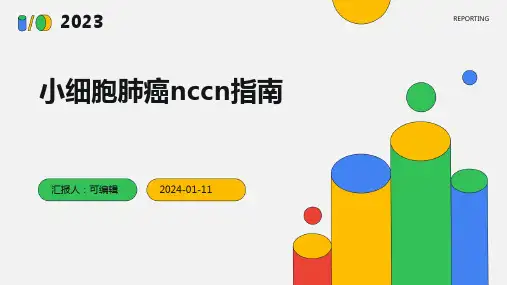

快速掌握:2017NCCN小细胞肺癌指南要点2017年2月23日,NCCN推出最新版(2017 Version3)小细胞肺癌(SCLC)指南,这里对更新点和各种治疗原则进行了整理,希望对你有所帮助。
主要更新点1. 2017 V3版相比2017 V2版指南:肺神经内分泌肿瘤的内容被移到神经内分泌肿瘤NCCN指南。
2. 2017版相比2016版指南:小细胞肺癌的后续系统治疗:•l拓扑替康从1类推荐改为2A类推荐;•l异环磷酰胺不再作为一种治疗选择;•lNivolumab ± 伊匹单抗可作为一种治疗方案(2A类)。
手术治疗的原则1. I期SCLC的患者占全部SCLC患者不到5%。
2. 分期超过T1-2, N0的患者,不能从手术获益。
3. 经过标准分期评估(包括胸部及上腹部CT、脑部扫描及PET/CT成像)的I期SCLC患者(T1-2, N0),可以考虑进行手术切除。
(1)手术切除前,所有患者均需要进行纵隔镜检查或其他侵入性纵隔分期以排除隐匿性结节。
这也可以包括内窥镜分期操作。
(2)进行完全性手术切除的患者(优选肺叶切除术联合纵隔淋巴结清扫或取样)需进行术后系统治疗。
未发现淋巴结转移的患者可仅进行系统治疗。
发现淋巴结转移的患者需要进行术后系统治疗同步联合纵隔放疗(RT)。
4. 预防性颅脑照射(PCI)在完全或者部分缓解的SCLC患者中可以改善无疾病生存及总生存期。
对于完全切除的患者,推荐在辅助系统治疗后进行PCI。
但是,在体能状态不佳或者神经认知功能受损的患者中不推荐PCI。
支持治疗的原则1. 建议戒烟,使用5A原则:询问(Ask),建议(Advise),评估(Assess),帮助(Assist),安排(Arrange)。
2. 粒细胞集落刺激引子(G-CSF)或粒细胞-巨噬细胞集落刺激因子(GM-CSF)不推荐在系统治疗同步联合放疗时使用(不推荐使用GM-CSF为1类推荐)。
3. 抗利尿激素分泌异常综合征:•l限制液体摄入;•l有症状患者输注生理盐水;•l抗肿瘤治疗;•l地美环素;•l血管加压素受体抑制剂(考尼伐坦,托伐普坦)。
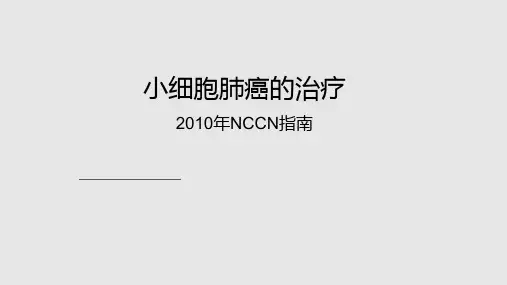


NCCN 肿瘤临床实践指南(NCCN 指南)®) 小细胞肺癌版本 3.2020—2020 年 2 月 5 日由于译者水平有限,难免会存在错误和纰漏,仅供谨慎参考。
继续INITIAL EVALUATION aDIAGNOSISSTAGENote: All recommendations are category 2A unless otherwise indicated.Clinical Trials: NCCN believes that the best management of any patient with cancer is in a clinical trial. Participation in clinical trials is especially encouraged.小细胞肺癌 (SLCL) 或• H&P b• 病理学审查c • CBC• 电解质、肝功能检查 (LFT)、BUN 、肌酐• 胸部/腹部/骨盆 CT 伴参见附加部分 检查 (SCL-2)SCLC/非小细胞肺癌 (NSCLC) 联合治疗 对比 • 脑部 MRI 对比a,d (首选)或 CT 有原发或转移部位活检或细胞学检查• 考虑 PET/CT 扫描(颅底至大腿中部),如果怀疑分期有限或需要澄清阶段a 、e 、f• 戒烟咨询和干预。
参见 NCCN 戒烟指南.• 分子分析(仅用于从不 广泛期吸烟者)f参见初始 治疗 (SCL-5)a 如果建立了广泛分期,可选择进一步分期评价。
但是,所有患者均应进行脑成像、MRI (首选)或 CT 造影。
b 见小细胞肺癌的体征和症状 (SCL-A).c 见病理学审查原则 (SCL-B).d 在识别脑转移瘤方面,脑部 MRI 比 CT 更敏感,并且优于 CT 。
INITIAL EVALUATION aDIAGNOSISSTAGENote: All recommendations are category 2A unless otherwise indicated.Clinical Trials: NCCN believes that the best management of any patient with cancer is in a clinical trial. Participation in clinical trials is especially encouraged.e 如果 PET/CT 不可用,骨扫描可用于识别转移灶。
肿瘤临床实践指南(NCCN Guidelines®)小细胞肺癌(2020.v2)1、NCCN小细胞肺癌指南2.2020版从1.2020版更新包括:SCL-E 1 of 4 度伐单抗联合化疗(依托泊苷联合卡铂或顺铂)已被作为首选一线治疗方案(第1类),其次对于广泛的SCLC患者使用度伐单抗维持治疗2、NCCN小细胞肺癌指南1.2020版(2.2019版)中的更新包括:1.初始评估和分期(SCL-1)●对于原发灶或转移灶活检或细胞学检查确诊小细胞癌或小细胞/非小细胞混合型腺癌的患者,初始评估内容作了2点修改和1点补充:►CT平扫加增强扫描的检查部位在“胸部/腹部”基础上增加了“盆腔”;►PET-CT检查的指征,在原来“如果疑似局限期”基础上增加了一个指征:如果需要鉴别分期;►新增“行分子谱分析(仅适用于未曾吸烟的广泛期患者)”,以帮助鉴别诊断和评估潜在的靶向治疗选择。
2.广泛期小细胞肺癌的初始治疗(SCL-5)●对于在全脑放疗前接受系统性治疗的无症状脑转移患者,在每2个周期全身治疗后以及在治疗结束后应该复查脑MRI(首选)或CT平扫加增强扫描(SCL-6)。
如果在系统性治疗期间出现疾病进展,则开始行全脑放疗。
3.初始治疗后的疗效评估和监测(SCL-6)●新增1条对“预防性脑照射(PCI)”的脚注:►在已经进行完全切除、病理分期为I-IIA(T1-2,N0,M0)的SCLC患者中,接受PCI的获益情况尚不清楚。
参见“手术切除原则”(SCL-C)。
4.病理学检查原则(SCL-B)●病理学评估中新增1条“复合型SCLC的定义”:►复合型小细胞肺癌含SCLC和NSCLC两种组织学(鳞状细胞癌、腺癌、梭形/多形性、和/或大细胞)成分。
不要求说NSCLC组织学成分的百分比最少需要多少;当有任何比例的NSCLC与SCLC一起出现时,就可称为复合型SCLC。
5.手术切除原则(SCL-C)●有淋巴结转移的患者,术后辅助治疗方案根据淋巴结分期作了修改:►旧版:有淋巴结转移的患者应接受术后同步系统性治疗和纵隔放疗。
NCCN2020.02⼩细胞肺癌(中⽂)肿瘤临床实践指南(NCCN Guidelines?)⼩细胞肺癌(2020.v2)1、NCCN⼩细胞肺癌指南2.2020版从1.2020版更新包括:SCL-E 1 of 4 度伐单抗联合化疗(依托泊苷联合卡铂或顺铂)已被作为⾸选⼀线治疗⽅案(第1类),其次对于⼴泛的SCLC患者使⽤度伐单抗维持治疗2、NCCN⼩细胞肺癌指南1.2020版(2.2019版)中的更新包括:1.初始评估和分期(SCL-1)●对于原发灶或转移灶活检或细胞学检查确诊⼩细胞癌或⼩细胞/⾮⼩细胞混合型腺癌的患者,初始评估内容作了2点修改和1点补充:CT平扫加增强扫描的检查部位在“胸部/腹部”基础上增加了“盆腔”;?PET-CT检查的指征,在原来“如果疑似局限期”基础上增加了⼀个指征:如果需要鉴别分期;新增“⾏分⼦谱分析(仅适⽤于未曾吸烟的⼴泛期患者)”,以帮助鉴别诊断和评估潜在的靶向治疗选择。
2.⼴泛期⼩细胞肺癌的初始治疗(SCL-5)●对于在全脑放疗前接受系统性治疗的⽆症状脑转移患者,在每2个周期全⾝治疗后以及在治疗结束后应该复查脑MRI(⾸选)或CT平扫加增强扫描(SCL-6)。
如果在系统性治疗期间出现疾病进展,则开始⾏全脑放疗。
3.初始治疗后的疗效评估和监测(SCL-6)●新增1条对“预防性脑照射(PCI)”的脚注:在已经进⾏完全切除、病理分期为I-IIA(T1-2,N0,M0)的SCLC患者中,接受PCI的获益情况尚不清楚。
参见“⼿术切除原则”(SCL-C)。
4.病理学检查原则(SCL-B)●病理学评估中新增1条“复合型SCLC的定义”:复合型⼩细胞肺癌含SCLC和NSCLC两种组织学(鳞状细胞癌、腺癌、梭形/多形性、和/或⼤细胞)成分。
不要求说NSCLC 组织学成分的百分⽐最少需要多少;当有任何⽐例的NSCLC与SCLC⼀起出现时,就可称为复合型SCLC。
5.⼿术切除原则(SCL-C)●有淋巴结转移的患者,术后辅助治疗⽅案根据淋巴结分期作了修改:旧版:有淋巴结转移的患者应接受术后同步系统性治疗和纵隔放疗。